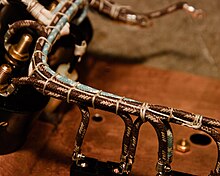


Cable lacing is a method for tying wiring harnesses and cable looms, traditionally used in telecommunication, naval, and aerospace applications. This old cable management technique, taught to generations of lineworkers,[1] is still used in some modern applications since it does not create obstructions along the length of the cable, avoiding the handling problems of cables groomed by plastic or hook-and-loop cable ties.
Cable lacing uses a thin cord, which is traditionally made of waxed linen, to bind together a group of cables using a series of running lockstitches. Flat lacing tapes made of modern materials such as nylon, polyester, Teflon, fiberglass, and Nomex are also available with a variety of coatings to improve knot holding.[2]

The lacing begins and ends with a whipping or other knot to secure the free ends. Wraps are spaced relative to the overall harness diameter to maintain the wiring in a tight, neat bundle, and the ends are then neatly trimmed. In addition to continuous or running lacing, there are a variety of lacing patterns used in different circumstances. In some cases stand-alone knots called spot ties are also used.[3] For lashing large cables and cable bundles to support structures in telecommunications applications, there are two named cable lacing styles: the "Chicago stitch" and "Kansas City stitch".[4]
Some organizations have in-house standards to which cable lacing must conform, for example NASA specifies its cable lacing techniques in chapter 9 of NASA-STD-8739.4.[5]
Every lineman should know how to sew these knots.